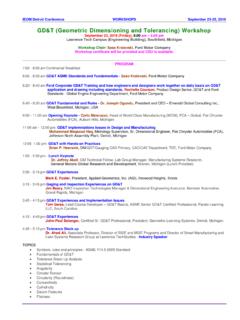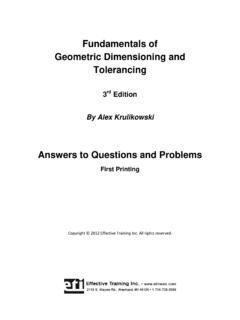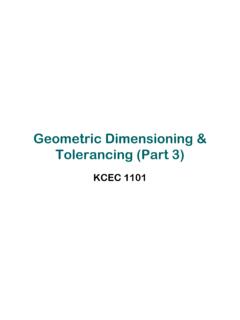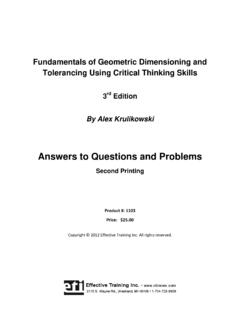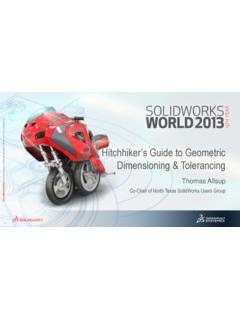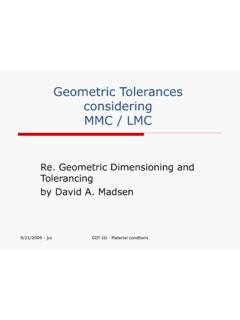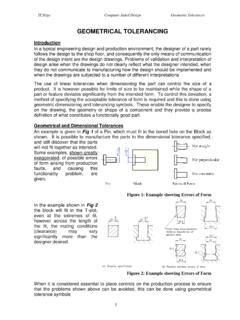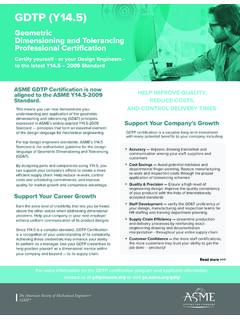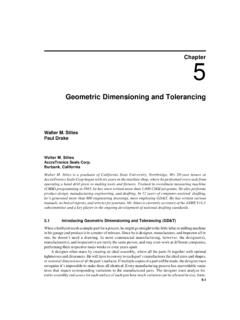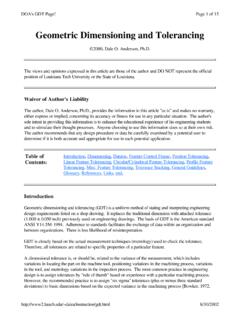Transcription of GEOMETRIC TOLERANCING - Department of …
1 TYPES OF CONTROL NEEDED FOR PARTSPOSITION OF FEATURES WITHIN PARTS(linear dimensions and diameters)Such as holesFORM or SHAPE of FEATURESSuch as straightness, angularityor parallelism of spesific portionsof the partGEOMETRIC TOLERANCINGG eometric dimensioning and TOLERANCING (GD&T) is a symbolic language used onengineering drawings and computer generated three dimensional solid models for explicitlydescribing nominal geometry and its allowable datum is a feature of a part that acts as a masterreference used to locate other features of the datum can be a point, a line, or a planeTheoretically exact dimensionsThe dimension determining the theoretically exact form, orientation or positionrespectively must not be toleranced.
2 The corresponding actual dimensions may onlyvary by the tolerances of form, orientation or position specified within the toleranceframe. This is illustrated in the figure belowType of toleranceGeometriccharacteristicsSymbolF ormStraightnessFormFlatnessFormCirculari tyFormCylindricityProfileProfile of a lineProfileProfile of a surfaceOrientationPerpendicularityOrient ationAngularityOrientationParallelismLoc ationSymmetryLocationPositional toleranceLocationConcentricityRunoutCirc ular runoutRunoutTotal runoutSymbolModifierFree stateLeast material condition (LMC)Maximum material condition (MMC)Projected tolerance zoneTolerances are given along with modifiersLMC: Least material condition of a component at that limit of size where the material of the feature is atits minimum everywhere, maximum hole diameter and minimum shaft : The dimension defining the least material condition of a :The size generated by the collective effect of the least material size, LMS of a feature and thegeometrical tolerance (form, orientation or location).
3 LMVC: Least material virtual condition. The condition of a component of least material virtual : Least material requirement, defining a geometrical feature of the same type and of perfect form,with a given dimension equal to LMVS, which limits a feature on the inside of the material :Maximum material size; The size of the maximum material : Maximum material virtual condition, is a perfect form condition of the : Maximum material virtual size, is the size generated by the collective effect of the maximummaterial size, MMS, of a feature of size and the geometrical tolerance (form, orientation or location)given for the derived feature of the same feature of size. Maximum material virtual size, MMVS, is aparameter for size used as a numerical value connected to : Projected tolerance zone.
4 A GEOMETRIC tolerance zone which projects from an actual design featuressuch as a holeMaximum Material RequirementThe minimum assembly clearance occurs when each of the mating components is at itsmaximum material size ( the largest pin size and the smallest hole size) it additionally occurswhen the geometrical deviations the form, orientation and location deviations of thecomponents size and their derived features centre line surface form are also at their Material RequirementAssembly clearance are maximized when the sizes of the assembled features of size are at leastmaterial size the smallest shaft size together with the largest hole size and when thegeometrical variations the form, orientation and location deviation and their derivedfeatures are at tolerance zonesIn some cases, the tolerance of orientation and position shall apply not to the feature itself but tothe external projection of it.
5 Such projected tolerance zones shall be indicated by the symbol P (incircle)Free StateThis condition applies to parts made of elastic or plastic materials or of thin flexible free state condition of a part: it is not restrained and subjected only to the force of distortion of such a part should be such that it will be brought within the specified tolerances forverification at assembly or by assembly using forces expected under the normal assembly example of how a free state geometrical tolerance is applied is provided in the figure below. Theinterpretation of this figure is that the tolerances followed by shall apply in the free state. The othertolerances apply in the assembled conditionError MeasuredValueTrue Value MeasurementUncertaintyThe difference betweenmeasurement errorandmeasurement uncertaintyshould be explained clearly to evaluate the measurement results the difference between the "true value" and thevalue found by a to the Guidance to Expression of Uncertainty in Measurement(GUM), measurement errors are distinguished as random and systematic Error and UncertaintyRandom ErrorRandom error in measurementtypically arises from unpredictable variationsof influencequantities.
6 These random effects under apparently equal condition at a given position giverise to variations in repeated observations of the it is not possible tocompensate for the random error of a measurement result, it can usually be reduced byincreasing the number of observations and only be expressed errorsinclude: positioning and allignment errors, non-determinable fluctiations in ambientconditions, transient fluctiations in the friction in the instrument and operator errors such asreading ErrorSystematic error, like random error, can not be eliminated but it can be asystematic error arises froma recognized effect of an influence quantity on a measurementresult, hereafter termed a systematic effect, the effect can be quantified anda correctionorcorrection factorcan be applied to compensate for the effect.
7 Recognized systematic errorscan generally be correlated with position along an axis and can be corrected for if therelative accompanying random error is small errors can often becompensated to a certain degree using calibration errors includecalibration errors and changes in ambient errors cannot be compensated for without real time measurement andfeedback into correction servo loop. Thus whenevaluating the error budget for a machinetwo distinct sub-budget based on systematic and random errors should be ME410 lecture notes for more information about random and systematic errors: 0,000,050,100,150,200,250,305,96,16,36,5 6,76,97,1 Pzz Type A UncertaintyMeasurement UncertaintyThe lack of exact knowledge of the value of the measurand explains theuncertainty of the result of a result of a measurement aftercorrection for recognized systematic effects is still only an estimate of themeasurand s value due to the uncertainty arising from random effects and fromimperfect correction of the result for systematic is used to describe an interval in which the true value can be expected to lie with a specified level of confidence(p).
8 For example, ifucis assumed to represent a normal (Gaussian) uncertainty distribution, then a interval corresponds to using an expanded uncertainty obtained with kp=395%95%99%99% (8) Combined Standart UncertaintyExpanded Uncertainty (k2)Expanded Uncertainty (k3)ppcppcUkuyU Y yUuUU= + = =1221()e, 2 Standart1() Deviation1 Uncertainty( )Arithmetic Mean ofRepeated MeasurementsNumber of Repeated MeasurementsStandart Deviation= === = ====== niiizxfxzxnuxnxnn Measurement Uncertainty (Continued)A generally accepted rule:Measuring accuracy should be within the 10% of the workpiece that standart deviation in the dimensions of products is pdue torandom causes only.
9 Then in order to have at least of the productsacceptable, the manufacturing tolerance should be T 6 p. 3 2 + 3 + 2 + Square PrincipleMost probable value of the observed quantities is the one which renders sum of thesquares of residual errors a Single variable arithmetic mean: X = xi/n- Two dependent variables ex: straight line Y = aX + b()()()2,,== == iiiiixyx ynnxxyya byaxxxx1x2x3x4xn 1xny1y2y3y4yn :::::Uncertainty Source Chart
